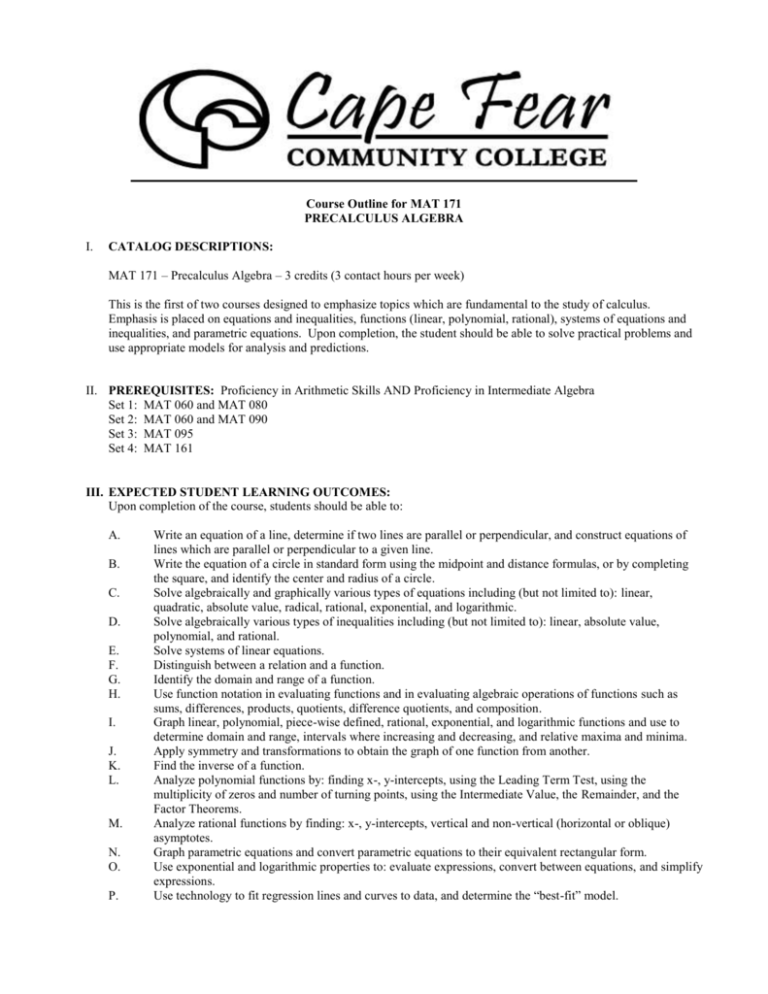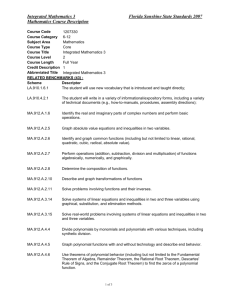
Course Outline for MAT 171
PRECALCULUS ALGEBRA
I.
CATALOG DESCRIPTIONS:
MAT 171 – Precalculus Algebra – 3 credits (3 contact hours per week)
This is the first of two courses designed to emphasize topics which are fundamental to the study of calculus.
Emphasis is placed on equations and inequalities, functions (linear, polynomial, rational), systems of equations and
inequalities, and parametric equations. Upon completion, the student should be able to solve practical problems and
use appropriate models for analysis and predictions.
II. PREREQUISITES: Proficiency in Arithmetic Skills AND Proficiency in Intermediate Algebra
Set 1: MAT 060 and MAT 080
Set 2: MAT 060 and MAT 090
Set 3: MAT 095
Set 4: MAT 161
III. EXPECTED STUDENT LEARNING OUTCOMES:
Upon completion of the course, students should be able to:
A.
B.
C.
D.
E.
F.
G.
H.
I.
J.
K.
L.
M.
N.
O.
P.
Write an equation of a line, determine if two lines are parallel or perpendicular, and construct equations of
lines which are parallel or perpendicular to a given line.
Write the equation of a circle in standard form using the midpoint and distance formulas, or by completing
the square, and identify the center and radius of a circle.
Solve algebraically and graphically various types of equations including (but not limited to): linear,
quadratic, absolute value, radical, rational, exponential, and logarithmic.
Solve algebraically various types of inequalities including (but not limited to): linear, absolute value,
polynomial, and rational.
Solve systems of linear equations.
Distinguish between a relation and a function.
Identify the domain and range of a function.
Use function notation in evaluating functions and in evaluating algebraic operations of functions such as
sums, differences, products, quotients, difference quotients, and composition.
Graph linear, polynomial, piece-wise defined, rational, exponential, and logarithmic functions and use to
determine domain and range, intervals where increasing and decreasing, and relative maxima and minima.
Apply symmetry and transformations to obtain the graph of one function from another.
Find the inverse of a function.
Analyze polynomial functions by: finding x-, y-intercepts, using the Leading Term Test, using the
multiplicity of zeros and number of turning points, using the Intermediate Value, the Remainder, and the
Factor Theorems.
Analyze rational functions by finding: x-, y-intercepts, vertical and non-vertical (horizontal or oblique)
asymptotes.
Graph parametric equations and convert parametric equations to their equivalent rectangular form.
Use exponential and logarithmic properties to: evaluate expressions, convert between equations, and simplify
expressions.
Use technology to fit regression lines and curves to data, and determine the “best-fit” model.
Q.
Apply the skills A – P above to assorted real-life scenarios and problems while demonstrating the ability to
interpret, analyze, and solve the problem.
Caveat: The purpose of problem solving is not merely to obtain an answer but also to extend and cultivate the ability to think
independently and creatively, beyond the mere application of computing rules. During the course, the student is
encouraged and expected to develop a conceptual grasp of the topics and to develop the ability to move effortlessly
between mathematical results and their interpretations.
V.
METHODS OF INSTRUCTION:
A.
Lectures on basic concepts and skills
B.
Class and team discussion of topics
C.
Skill building in-class exercises
D.
Team projects which employ critical thinking to enhance concept development and to apply course skills to
real life problems and scenarios.
VI.
CONTENT:
A.
Graphs of Functions and Modeling: Graphs of equations, distance formula, midpoint formula, circles,
functions and function notation, domain and range of functions, linear functions, slope and rate of change,
equations of lines, perpendicular and parallel lines, graphing linear functions, linear models and application,
linear regression, solving linear equations and inequalities.
B.
Systems of Linear Equations: Geometry of and solving systems in two variables, geometry of and solving
systems in three (or more) variables, using matrices to solve systems of linear equations.
C.
Properties and Operations of Functions: Increasing and decreasing, relative maxima and minima,
applications, piecewise defined functions, the algebra of functions, function composition, symmetry and
transformations.
D.
Quadratics Functions, Equations and Inequalities: Complex numbers and arithmetic operations, quadratic
equations and functions, solving quadratic equations using completing the square and the quadratic formula,
equations reducible to quadratic, applications, analyzing graphs of quadratic functions, solving rational and
radical equations, solving equations and inequalities with absolute values.
E.
Polynomial and Rational Functions: Polynomial functions and modeling, zeros of polynomials, graphing
polynomial functions, polynomial division, the Remainder and Factor theorems, rational functions – domain
and range of, vertical and non-vertical asymptotes, applications of, solving polynomial and rational
inequalities.
F.
Parametric Equation: Graphing and determining a rectangular equation for parametric equations, determining
parametric equations for a given rectangular equation, applications.
G.
Exponential Functions: Inverses and one-to-one functions, finding formulas for inverses, graphing
exponential functions, properties of exponential functions, the number e and graphs of exponential functions
base e , applications, graphing the inverse of an exponential function.
H.
Logarithmic Functions: Graphs and properties of their graphs, converting between exponential and
logarithmic equations, changing bases, properties of logarithmic functions, applying the properties,
simplifying expressions involving exponentials and logarithms, solving exponential and logarithmic
equations, application and models for growth and decay.
VII.
TYPICAL ASSIGNMENTS:
A.
In-class participation during lecture
B.
Online or textbook homework
C.
Quizzes
D.
Online or in-class “chapter” tests
E.
Projects and labs which apply the course skills and enhance the understanding of course concepts by solving
applied problems.
F.
Comprehensive final exam
VIII.
EVALUATION:
A.
Methods of Evaluation
1.
Objective quizzes and tests on topics covered in lecture, reading assignments, or other assignments.
Typical questions:
a. Let f ( x )
a) h(a 1)
g
( 2) =
h
c)
x 2 , g ( x) 3 x 8 , and h( x) 6 x 2 , then
b) ( f h)(3) =
d) ( f h)( x) =
b. If P is a polynomial of smallest degree with a zero of multiplicity two at x = 3,
and zeros of multiplicity one at both x = −1 and x = 2, then an expression
(leave in factored form) for P is
P(x) =
.
c. Solve the logarithmic equation ln( x 7) ln( x 5) 2 ln x . Simplify your
answer.
2.
3.
4.
5.
B.
Review and evaluate skill-building assignments providing students with constructive feedback.
Critique critical thinking application projects for clarity, process, and completeness as well as
accuracy while providing timely feedback.
Assess skill-building worksheets for clarity, process, and completeness as well as accuracy while
providing timely feedback.
Assess comprehensive final exam on both process and accuracy of solutions.
Frequency of Evaluation
1.
Periodic tests, quizzes: minimum 3 tests per semester, quizzes optional; with no more than 40% of
work being completed online
2.
Weekly homework assignments with feedback provided weekly
3.
Critical thinking projects: at least one per semester.
4.
Comprehensive final: one at end of semester
IX.
TYPICAL TEXT: Precalculus: Graphs and Models, 5th Edition by Bittinger, Beecher, Ellenbogen and Penna,
published by Pearson Addison Wesley.
X.
OTHER SUPPLIES REQUIRED OF STUDENTS:
1. A graphing calculator is required.
2. My Math Lab student access code is required.
3. It is highly recommended that students in Distance Education sections of the course have internet access.
Creation date:
Revision date:
Revision date:
Revision date:
September 25, 2009
November 14, 2009
June 20, 2011
June 25, 2012








